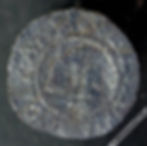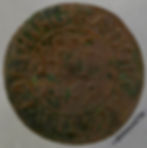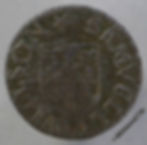THE FIRST PRIVATE TOKENS
There is evidence of privately issued leaden tokens at or before this time, as some of the legislation was aimed at suppressing them in favour of the official farthings, but the few that have survived are so crudely made and cryptically designed that very little can now usefully be said of them.
The first tokens that were made in the same way as coins, in being struck from dies and carrying statements about their issuers and values, appeared during the Cromwellian Commonwealth in the middle of the seventeenth century. Despite being completely illegal they satisfied a vital economic need and a vast number of types exist, probably as many as 20,000, of which over half are from the vicinity of London. Although not much more substantial than the earlier regal tokens, they found greater acceptance possibly because they were local issues by someone at least nominally responsible for their redemption. Considering their small size and the rather primitive technology available to make them, they could convey a surprising amount of information. As well as the issuer's name and place of business, they might add his occupation, the date, the arms of his merchant guild, the initials of his and his wife's names arranged in a conventional triangular form, and a redemption promise such as his - sometimes her - halfpenny. This insight into the everyday life of the merchant class 350 years ago, along with a unique view of the commercial history of towns and villages throughout the country, added to the extreme rarity of so many of the issues, has long fascinated collectors. They deserve the status accorded them as the classic token series.
TOWN ISSUES
In addition to the issues of individual merchants and traders many town authorities issued tokens. The Elizabethan poor laws placed a responsibility on every parish to maintain anyone born there who became destitute. Before the erection of workhouses this could only be achieved by giving goods or money, so the availability of small change was vital to the smooth running of the system. Many of the town tokens mention the poor in their legends, and they occur in larger numbers than most private issues. The corporation of Bristol, then England's second city, was a particularly prolific issuer.
CHARLES II
The tokens continued even when the Commonwealth ended upon the restoration of Charles II, but they did not please everyone. They broke important principles of intrinsic value and royal authority, and they might be refused if taken any distance from where the issuer lived; but the tokens persisted despite official attempts to suppress them as long as the need for them remained unfilled by any other means. In 1672 the authorities took the bull by the horns and at last issued copper halfpennies and farthings of a substantial size. Even these did not contain their full value in copper but they were far larger than any of the coins or tokens that had preceded them. Once the new coins became freely available the private tokens were no longer either needed or acceptable, and they rapidly disappeared from circulation.





















































































